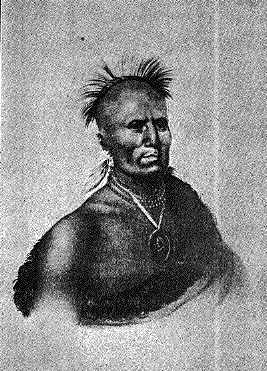
NEGenWeb Project
On-Line Library
NEBRASKA HISTORY MAGAZINE |
217 |
REFERENCES TO THE PAWNEE BY EARLY AMERICAN EXPLORERS
The Ashley-Smith Explorations and the Discovery of a Central
Route to the Pacific. 1822-1829.
With the Original Journals edited by Harrison Clifford Dale
"After ascending the river about one hundred miles, we reached Plumb Point on the 3d December, where we found the encampment of the Grand Pawney Indians, who had reached that point (their usual crossing place) on their route to the wintering ground on the Arkansas River.
(Foot note: Plumb Point is the southermost (sic) point of the Platte River a few miles south of Kearney, Buffalo County, Nebraska. There are a number of trails by which the Pawnees crossed to the Arkansas.
Rev. John Dunbar's Report on the Pawnee.
Reprint of the original MSS of Missionary Life Among the Pawnees, by Rev. John Dunbar. Vol. 16, Nebr. Hist. Soc. Publications pp. 276. The period of this description is 1834- 1847.
''The Pawnees are divided into four distinct bands. These are the Grand Pawnees, the Republican Pawnees, Pawnee Loups, and Tapage Pawnees. The Grand Pawnee village is on the south side of the Platte 130 miles from its junction with the Missouri. Tapage and a part of the Republican band live in the same village on the north side of the Loup fork of the Platte, 30 miles above its mouth. The other part of the Republican band live in a little village 4 miles above the Tapage on the same stream. The Pawnee Loups have a village on the Loup fork 3 miles above the little Republican village. The four villages have a population of 8000 or 10,000 souls, and may all be visited by riding 30 miles. It may be questioned whether there be another spot in the whole Indian country where so many immortal beings may be visited with so little travel."
Fremont’s Report 1842.
Report of The Exploring Expedition to the Rocky Mountains in the year 1842, by Brevet Captain J. C. Fremont. Gales and Seaton, Printers Washington, 1845.
"On the 22d we arrived at the village of the Grand Pawnees on the right bank of the river, about thirty miles above the mouth of the Loup fork. They were gathering in their corn, and we obtained from them a very welcome supply of vegetables."
Sharitarish, the Pawnee Chief.
"History of the Indian Tribes of North America with Biographical Sketches and Anedotes (sic) of the Principal Chiefs.
| 218 | NEBRASKA HISTORY MAGAZINE |
Embellished with one Hundred and twenty Portraits from the Indian Gallery in the Department of War, at Washington.
By Thomas L. McKenney late of the Indian Department. Washington, and James Hall, Esq., of Cincinnati.
Three volumes published at Philadelphia, by J. T. Bowen--1848
page 33
"Sharitarish was principal chief, or lead man of the Grand Pawnees. He was descended from a line of chiefs, an according to the law of descents, which selects the next of kin, if worthy, succeeded his elder brother, Tarecawawaho. They were sons of Sharitarish, a chief, who is mentioned in Pike's Expedition under the name of Characterish."
Sharatarish as Described by Long.
Pub. London, 1823 Longman, Three Vols. |
''Account of an Expedition From Pittsburgh to the Rocky Mountains, Performed in the Years 1819-1820.By order of the Hon. T. C. Calhoun. Secretary of War , Under the Command of Maj. S. H. Long, of the U. S. Top. Engineers. Compiled front the notes of Major Long, Mr. T. Say, and other gentlemen of the party, by Edwin James, Botanist and geologist to the expedition. |
''A chief was soon observed advancing with rapidity; he was received by our cavalcade with music playing, and flags displayed, and was recognized to be Sharitarish, eldest son of the, chief of that name commemorated by Lieutenant Pike, and now second chief of the Grand Pawnees."
* * * * * * *
''The interpreters being absent, no particular communication was interchanged, and we moved on. A short time. however, only elapsed before Tarrarecawaho approached in full dress. We could not choose but admire the lofty dignity of his appearance; but his extreme hauteur became manifest when he halted at the head of our line by not offering his hand, or even deigning (sic) to look at us. *
''We passed by and saluted the, mansions of the chiefs, at each of which an American flag was hoisted with the exception only of one that was passed unnoticed, owing to its being distinguished by a Spanish flag: which, however, was struck as soon as the cause of the procedure was understood."
The meeting thus described was at the village of the Grand Pawnee in the valley of the Platte, near the Loop river as is shown by the text on the previous paragraph: "After riding a considerable distance over a beautiful plain, we came in view of the village of the Grand Pawnees, and saw in every direction

SHAR-I-TAR-ISH
Shar-i-tar-ish was a principal chief of the Grand Pawnee tribe. He was son of another chief of the same name mentioned as Char-ac-tar-ish by Lieutenant Pike who met him at the Grand Pawnee village on the Republican river in 1806. The subject of this portrait succeeded his elder brother, Ta-re-ca-wa-ho as head chief. The latter was invited to visit the president at Washington but refused because he thought the Pawnee the greatest people on earth and would not condescend to go in person. He sent Shar-i-tar-ish in his stead. Shar-i-tar-ish was then a young man, six feet, tall, well proportioned and of fine appearance. His portrait was made at Washington. Soon after his return he became head chief and died a little later, aged thirty. He was succeeded by Ish-ca-te-pi sometimes spelled Is-ka-tap-pi and called "The Wicked Chief".
|
© 2004 for the NEGenWeb Project by Ted & Carole Miller |
||